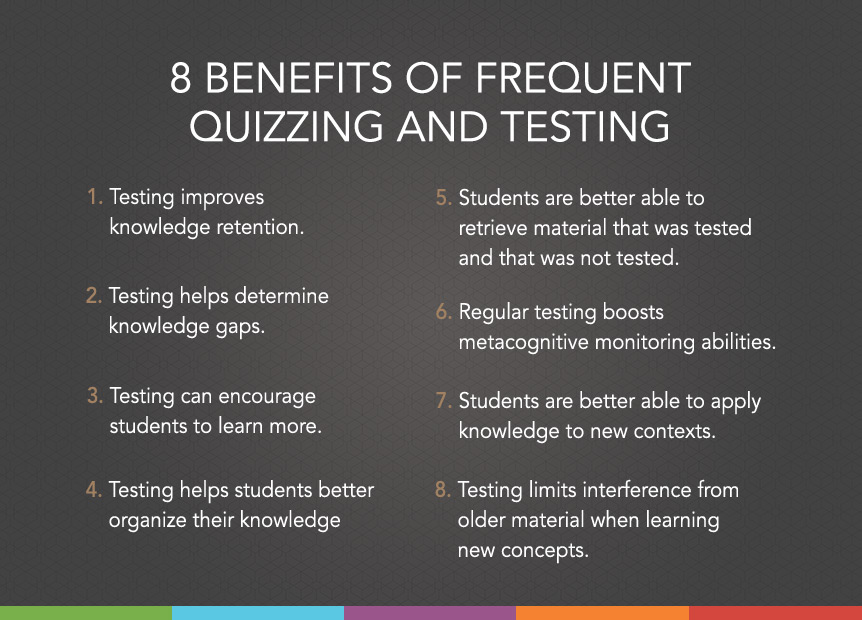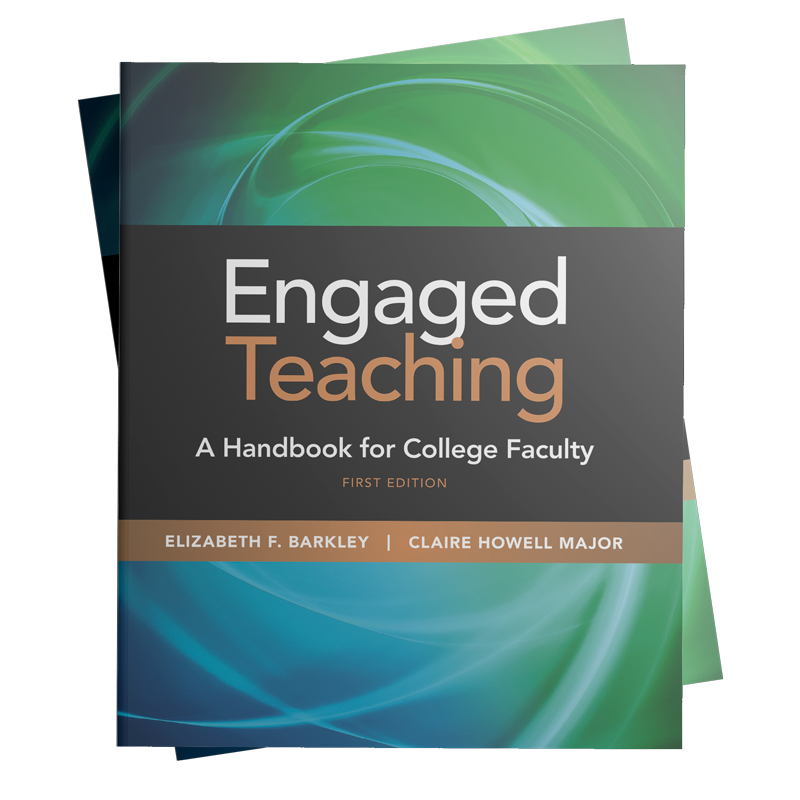
Few things strike fear in the hearts of students as much as tests, especially when knowing they will be used for summative assessment. Test anxiety aside, quizzes and tests can actually help students learn course content. Research demonstrates that the testing effect, which is sometimes called test-enhanced learning or retrieval practice, has a greater impact on student learning than simply re-studying course material or taking multiple-choice tests. Roediger et al (2011, p.2) put it this way:
If students are quizzed frequently, they tend to study more and with more regularity. Quizzes also permit students to discover gaps in their knowledge and focus study efforts on difficult material; furthermore, when students study after taking a test, they learn more from the study episode than if they had not taken the test…
There is decades worth of research suggesting that students who are frequently quizzed or tested have better educational outcomes than students who are not tested. In the middle of the 20th century, Fitch, et al (1951) studied whether frequent quizzes would improve student learning during a college lecture course. Over the course of their study, all participating students were taught the same material during lectures, completed the same reading assignments, and had time at the end of each class period for open discussion. The experimental group also completed a 10-minute quiz each week while the control group did not. At the end of the study period, students in the quiz group achieved significantly higher scores than the students in the control group, leading the researchers to conclude that: “frequent testing of achievement in the college lecture classroom may motivate such outside endeavors as will result in superior achievement” (p. 19).

Gaynor and Millham (1976) later affirmed that students who took weekly tests had significantly stronger performances on course examinations than students who only took midterm and final exams. Furthermore, the students who took weekly tests believed they’d learned more and actually said they liked their testing schedules more than their peers in the control group.
Even today, we’re seeing new research supporting the idea that frequent testing can help students improve their abilities to recall and retain information (for example: Bae, et al 2018; McDaniel et al., 2007). One difference we see among recent studies is the measurement of the “stakes” of the tests. For instance, Schrank (2016) concluded that frequent “low-stakes” quizzing in an introductory sociology course resulted in several improved outcomes for students.

Benefits of Testing
The following list of testing benefits is adapted from Roediger et al.
- Testing improves knowledge retention.
By preparing for tests, students move information from their short-term to their long-term memory. - Testing helps determine knowledge gaps.
The feedback students receive from frequent testing helps them understand what concepts they might not fully understand and how they should prioritize future study habits, improving their overall learning. - Testing can encourage students to learn more.
By practicing their information retrieval skills, students can improve their learning during future study periods. In other words, students who are restudying material they’ve already been tested on learn more than if they’d revisited the material without testing, an idea known as test-potentiated learning. - Testing helps students better organize their knowledge.
Retrieval practice helps students perform better, in part, because students are encouraged to organize their information more effectively than they would if they were just reading material. Students are more likely to pay attention to important points and categorize it into an effective recall structure. - Students are better able to retrieve material that was tested and that was not tested.
One benefit of testing that may surprise you is that it helps student retention of material for non-tested information (at least if it is related to the tested material), in a process called retrieval-induced facilitation. - Regular testing boosts metacognitive monitoring abilities.
Testing can mitigate students’ overconfidence in their ideas about their learning (sometimes to the point of under confidence) and make them more aware of their own knowledge. Teachers may consider encouraging students to test themselves on their own while studying. - Students are better able to apply knowledge to new contexts.
Not only does consistent testing help students retain information, but they’re also more likely to be able to transfer their knowledge and use it in different contexts. - Testing limits interference from older material when learning new concepts.
One positive side-effect of testing is that it can prevent the effects of proactive interference, which can happen when topics are studied in succession. Proactive interference occurs when older material limits the retention of new material. By testing regularly, students avoid the trappings of poor retention caused by previous learning.
Cross Academy Techniques
Because so many of the benefits of the testing effect occur in the act of preparing for the quiz or test, teachers can help their students by giving them better structure for their test preparation. Here are a few Cross Academy Techniques that may help your students prepare for tests and quizzes:
These three-by-five-inch index cards are created by students to use on tests and exams, giving them the opportunity to write down any information they think may be useful to them.
Students are asked to develop a few test questions related to the topic and then develop an answer sheet to accompany the test questions.
Students must complete a content unit, determine a central question and develop their answer to it; then exchange their questions with a classmate and come up with responses to each other’s questions; and then read their answers and compare them to model and/or in-class responses.
Email us to receive information about new blog posts.
References
Bae, C. L., Therriault, D. J., & Redifer, J. L. (2018). Investigating the testing effect: Retrieval as a characteristic of effective study strategies. Learning and Instruction, 60, 206–214.
Fitch, M. L., Drucker, A. J., & Norton, J. A. (1951). Frequent testing as a motivating factor in large lecture classes. Journal of Educational Psychology, 42(1), 1–20.
Gaynor, J., & Millham, J. (1976). Student performance and evaluation under variant teaching and testing methods. Journal of Educational Psychology, 68(3), 312–317.
McDaniel, M. A., Anderson, J. L., Derbish, M. H., & Morrisette, N. (2007). Testing the testing effect in the classroom. European Journal of Cognitive Psychology, 19(4-5), 494-513.
Roediger, Henry & Putnam, Adam & Sumeracki, Megan. (2011). Ten Benefits of Testing and Their Applications to Educational Practice. 10.1016/B978-0-12-387691-1.00001-6.
Schrank, Z. (2016). An assessment of student perceptions and responses to frequent low-stakes testing in introductory sociology classes. Teaching Sociology, 44(2), 118–127.
Suggested Citation
Barkley, E. F., & Major, C. H. (n.d.). 8 benefits of frequent quizzing and testing in your college class. CrossCurrents. https://kpcrossacademy.ua.edu/8-benefits-of-frequent-quizzing-and-testing-in-your-college-class/

Engaged Teaching
A Handbook for College Faculty
Available now, Engaged Teaching: A Handbook for College Faculty provides college faculty with a dynamic model of what it means to be an engaged teacher and offers practical strategies and techniques for putting the model into practice.








